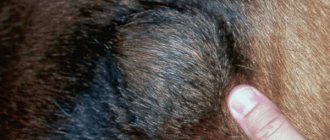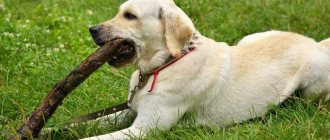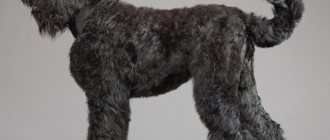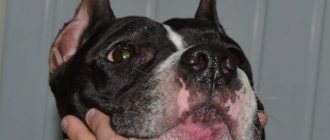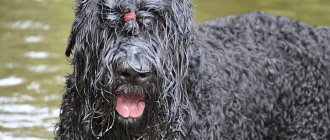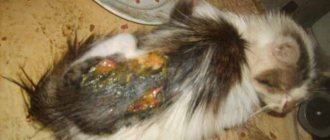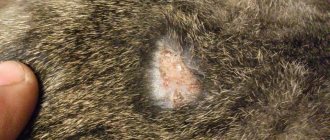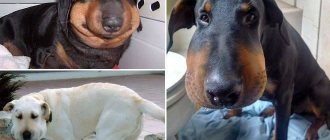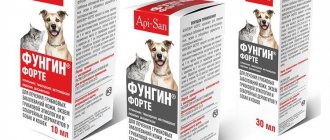What forms of acanthosis nigricans occur in dogs, why do they appear?
Acanthosis nigricans is a condition of hyperpigmentation of a dog's skin. It may be hereditary or acquired as a secondary manifestation of another skin disease. The inherited condition is seen exclusively in dachshunds and is likely to appear by the time the puppy is 1 year old. As a secondary disorder, it can appear in any breed at any age.
Acanthosis nigricans should be considered a clinical sign and not a diagnosis, especially if it is a secondary disease. It is usually associated with inflammation caused by friction of the skin. The primary disorder is very rare and is classified as genodermatoses (hereditary).
Primary (genetic)
Veterinary medicine is not exactly sure of the causes of the hereditary form of acanthosis nigricans.
But assume that inheritance is:
- autosomal recessive;
- polygenic.
Polygenic refers to a condition or trait that is controlled by two or more genes. Autosomal recessive inheritance describes the mode of transmission of many disorders. For example, in a puppy that has two copies of the defective gene, the disease will appear as black pigment spots. And for someone who has only one gene, it will not appear at all.
Important! It is recommended that dachshunds be tested for the presence of the defective gene. And if it is detected, then exclude them from further breeding
.
The disease occurs in dachshunds of any gender. But it is being diagnosed less and less due to the increased ability to distinguish it from more common causes of axillary hyperpigmentation (allergies and microbial infections).
Secondary
Secondary acanthosis nigricans can be detected in representatives of any breed of both sexes.
Those dogs that have a tendency to:
- development of inflammation of the skin in the groin, folds between the paws and torso;
- obesity;
- dermatitis;
- underactive thyroid gland;
- food allergies;
- diabetes mellitus;
- endocrine imbalance, including hypothyroidism, Cushing's disease or sex hormone imbalance.
Pseudoacanthosis
Pseudoacanthosis nigricans is a benign acanthosis that is associated with obesity. It may be a marker of high insulin levels in an overweight pet.
The development of symptoms is promoted by:
- bending of the skin fold;
- warm;
- friction.
But this form of the disease does not necessarily appear in well-fed dogs. It can be caused by treatment with corticosteroids in combination with a predisposition to obesity.
Important! Always follow your veterinarian's instructions when treating your dog if an antibiotic or topical ointment is used. If you do not treat at all or interrupt the course early, the affected area of the skin may begin to become inflamed again.
Pseudoacanthosis is a short-term pathology. If one of the symptoms that triggered it disappears (obesity or corticosteroids), then the problem will also disappear. Don't expect relief the next day or a week later. Skin diseases go away very slowly, over several months. And they are necessarily accompanied by treatment.
Reasons for appearance
Most dog breeders believe that acanthosis affects only the dachshund. However, this is far from the true state of affairs. Veterinarians distinguish three types of the disease, namely: primary, secondary and pseudoacanthosis. Each of them has its own characteristics and characteristics. Let's take a closer look at these subspecies.
Primary form of acanthosis
It affects exclusively dachshunds, regardless of their gender or age. Most often, the first symptoms occur in young individuals who have not yet reached a year of age. This factor leads experts to believe that the cause of acanthosis nigricans lies in family history. In other cases, the phenomenon of “elephant skin” may be associated with various disorders of the endocrine system or kidneys.
Secondary form
Dogs of any breed can suffer from it, but smooth-haired members of the family are especially vulnerable. In this case, roughening of the skin acts as a “background” symptom of any underlying ailment. Common reasons include:
- Neoplasms with oncological etiology.
- Pathologies of the pet’s internal organs.
- Inflammatory processes affecting the genitourinary system.
- Dysfunctions in the thyroid gland.
- Intense and regular stress experienced by the dog.
- Excessive obesity and poor ecology.
- Poor quality industrial feed and poor diet.
Pseudoacanthosis
In veterinary medicine, this term refers to various chronic or acquired skin problems in dogs, whose symptoms are absolutely identical to acanthosis. They are provoked by factors such as allergic reactions, dermatitis, disruptions in the endocrine system, the predominance of fatty foods in the dog’s menu and too little physical activity.
How do symptoms appear?
Acanthosis appears as darkening of the skin in the folds of the upper legs or groin. The fur falls out over time, leaving a dark, dense, leathery patch. Over time, the spot becomes inflamed as the condition develops and worsens if left untreated. Yeast or bacterial infection begins to multiply on its surface. This causes itching. The dog scratches the itchy skin, which leads to other problems.
Characteristic features of the disease:
- pigmentation is usually bilateral, i.e. observed on the left and right sides of the groin or armpits;
- the edges of the spots will be reddened;
- possible seborrhea;
- Over time, the spot increases in size.
Itching is not the main symptom as it may come and go. There is also no pain at the initial stage, and then it can cause some discomfort. Alopecia will develop as the disease progresses.
Why does acanthosis occur?
The appearance of black spots on an animal’s body can be associated with a number of factors:
- unbalanced diet, in which owners mix natural food and dry food;
- unfavorable environmental conditions. It is no secret that during walks, dogs' skin is exposed to reagents that can cause the development of dermatitis in winter or photodermatosis when exposed to sunlight in summer;
- sedentary lifestyle. Lack of physical activity and poor diet can cause metabolic disorders in the animal, which can be accompanied by increased pigmentation, acne and itchy skin;
- breed predisposition;
- lentigo is a skin lesion that is more cosmetic in nature and has no treatment;
- Dermatophytosis is a fungal disease, a sign of which is dark spots on the body of the animal. The surface of the spots may peel off, become covered with crusts and scabs. The disease is accompanied by severe skin itching;
- Weeping dermatitis, in which dark spots form when the dog constantly scratches the lesions.
Since there are many causes of the disease, you should seek advice from a specialist who will correctly diagnose the disease and prescribe treatment.
How is the disease diagnosed?
Diagnosis of acanthosis is one of the simplest. You can hardly be mistaken if you see in front of you a hairless area with dark skin and a thick crust.
But, despite the simplicity, the doctor can:
- take a skin scraping;
- check the functions of the thyroid gland and adrenal glands;
- do a food allergy test.
Did you know? The skin is the largest organ in the body. Its weight is about 10% of the dog’s total body weight.
For dogs that have this hereditary condition, this number of tests is not necessary. Primary acanthosis is diagnosed through a physical examination and breed history, as well as a biopsy if necessary.
Signs and diagnostic methods
Characteristic symptoms for acanthosis nigricans are found in the armpits, groin area and other areas with increased thorns. Local changes:
- increased pigmentation - black and brown tint of the affected areas;
- thickening of pigmented areas of the skin;
- greasy foul deposits;
- itching – dogs scratch the affected areas;
- the pain is mild;
- erythema around the pigmented area.
The diagnosis of acanthosis is made taking into account the history, clinical signs and special studies. It is necessary to exclude other diseases that lead to darkening of the dog’s skin. Malossezia is a fairly common fungal infection caused by opportunistic microflora. Normally, these fungi inhabit the dermis of dogs, and when resistance drops, they cause dermatitis with the formation of a black pigment. For differentiation, it is necessary to take a scraping and make fingerprint smears - the yeast is detected under a microscope.
Black pigmentation is possible in hairless dog breeds. Due to the high activity of the sebaceous glands, they become clogged with secretions, dirt, and dead epithelium. Pigmented tubercles are formed. It is determined by diagnostic treatment - the dog is washed with a special shampoo that destroys these formations.
Pigmented skin tumors are often observed in pets. In appearance they are similar to acanthosis, but there is no overlap, and the dog does not experience itching. The diagnosis is confirmed by a biopsy of the affected area. If a tumor is detected, treatment should be carried out immediately, since melanomas quickly metastasize to other organs.
Treatment of acanthosis nigricans in dogs
The inherited condition of acanthosis nigricans in dogs has no cure.
But you can relieve symptoms with:
- antiseborrheic shampoo;
- essential oil;
- vitamin E;
- melatonin;
- corticosteroids.
Typically, the treatment regimen is chosen by the veterinarian. Dogs with this secondary condition will benefit from antimicrobial shampoo and veterinarian-prescribed topical skin ointments. The condition should improve over time and may even disappear completely.
In the initial stages
The development of acanthosis begins with the skin gradually changing color. It accumulates pigment - melanin. It looks like a normal patch of dirty skin. Then the epidermis thickens and skin roughness appears.
There is no treatment for the primary (genetic) form of the disease, but the condition of the affected epidermis can be improved.
They do this using cosmetic procedures:
- lighten the area with salicylic acid;
- washed 2-3 times a week with antibacterial soap.
Did you know? Dogs with fair skin are more susceptible to developing various skin diseases. Especially if they recently suffered a sunburn.
These treatments help improve the appearance of the skin. It is also important to eat a healthy diet. If your pet is obese, then he needs to lose weight. And be sure to control the use of medications that can cause illness.
If we are talking about a secondary form of the disease, then it is eliminated as the main one is cured:
- For an obese pet, it is enough to lose weight.
- Those with acanthosis as a result of a hormonal disorder can be helped with medication and lifestyle changes.
If this is not possible, for example for caudate patients with food allergies or diabetes, then the condition will be controlled by making changes to the diet.
Cosmetic procedures are required. They are aimed at improving the condition of the skin. Among them:
- creams that can soften and brighten the skin;
- laser therapy to reduce thickening;
- antibacterial soap.
| Cosmetical tools | Their properties |
| Espree shampoo with tea tree effect | Designed to reduce inflammation. Helps against itching and has antibacterial properties. Safe even for puppies. |
| Shampoo "Dermoscent Atop 7" | Product for allergic skin. It restores its acid-base balance. Thanks to the natural herbs in its composition, it has an anti-inflammatory and antipruritic effect. Gently removes peeling and softens rough areas. |
| Shampoo "Sinergy Labs antiseptic" | It is an antifungal and antiseptic agent. Recommended for allergies, hormonal disorders, genetic diseases and fungal infections. Heals and protects the skin. |
At advanced stages
In the later stages of the disease, the surface of the spot becomes covered with a thick crust. Cracks appear on it. If there is itching, then scratching is added and the risk of infection in the wounds increases.
Treatment with antihistamines is carried out if there is an allergic reaction. The doctor may prescribe Diazolin or Suprastin at a dosage of 2 mg/kg. It is also possible to prescribe other drugs in this group.
Did you know? Scientists believe that the first dogs lived 31,700 years ago. In appearance they resembled Siberian huskies.
If the skin is swollen, anti-inflammatory medications will be recommended. These are the drugs “Simaldzheks” at a dosage of 2 mg/kg once a day, “Carprofen” or “Rimadyl” at a dosage of 4 mg/kg, also once a day.
For severe swelling, corticosteroids are prescribed. Their action is aimed at relieving itching by blocking the substances that provoke it. Most often this is Prednisolone in a dosage of 0.5–1 mg/kg, divided into 2 doses per day.
In severe cases of the disease, the doctor will recommend medications in the form of injections. They act much faster. The medicine is administered subcutaneously or intramuscularly.
For severe hair loss, Melatonin is prescribed. Its action is aimed at restoring hair growth in places where there are bald patches. Dosage - 1 mg 3 times a day. The duration of the course is prescribed by the veterinarian depending on how much the pet is balding.
Folk remedies
In pharmacies you can buy many natural herbal remedies to relieve itching and inflammation of the skin. For owners of dogs with hereditary pathology, they are more suitable than other types of treatment - after all, the hereditary form of acanthosis nigricans cannot be treated, and the task of a caring owner is to reduce the pet’s discomfort.
Here is a list of some drugs and folk remedies that may be useful:
- Vitamin E. It softens and eliminates wrinkles and folds. It will be great if you buy vitamins in capsules and rub the contents of the capsule into your skin. It is liquid and oily, so this approach is possible. In addition, the oil warms the muscle and enhances the regenerating properties of the skin.
- Low-fat yogurt. It maintains a balance of beneficial bacteria in the gut and helps block the development of yeast on your dog's skin, as well as strengthening the immune system. For representatives of small breeds, 1 teaspoon per day is enough.
- Chamomile tea without sugar. It is applied to itchy spots. Iced tea kills yeast and bacteria and also reduces inflammation.
- Ground oatmeal. This is one of the best remedies against itching. It is applied to the affected area, and for large affected areas, baths are made for 5–7 minutes for the dog’s entire body.
- Heat compresses with Epsom salts can reduce swelling. And a bath with such salt speeds up the healing time of any small open ulcers and wounds, especially in combination with veterinary antibiotics.
- Evening primrose essential oil has active anti-inflammatory and antipruritic properties. It can be applied directly to the skin to calm allergic reactions and strengthen the immune system.
Important! Exercise reduces itching. More precisely, during favorite games and walks, the dog switches to these types of activities so well that it temporarily forgets about the itching.
How to care for a sick dog
Caring for your pet will be as normal as possible. After all, if the dog does not itch, then it practically does not feel any changes in the skin. You just need to add direct skin care in the form of baths 2-3 times a week or treatment of the affected area.
Other pet care measures include:
- providing the dog with a balanced diet that does not provoke allergies;
- adding vitamin complexes to stimulate the immune system;
- ensuring daily walks of at least 1 hour a day to maintain physical fitness and improve overall health;
- taking care of the skin: you should not allow your pet to become infected with fleas and other parasites, and you should also avoid prolonged exposure to the sun so as not to damage the epidermis even more;
- protect problem areas of the skin from mechanical damage and keep them clean and dry;
- When wounds appear, be sure to treat them with an antiseptic and wound-healing agents.
Diseases of the Dachshund breed - symptoms and treatment
For pets of any breed, it is important to follow the rules of feeding and hygiene, then the likelihood of developing skin dystrophy or obesity for the dog is significantly reduced.
But there are also diseases that an animal can contract after several years of life, for example diseases of the spine or ears. For example, a dog is already born with discopathy (this is a breed defect), and such puppies cannot be bred even after they are cured.
Let's look at diseases characteristic of dachshunds, as well as the actions that need to be taken when they are detected.
Spinal diseases
A common occurrence in dachshunds over the age of 5 years (although they can appear earlier) is back disease. They are expressed in the fact that the always active and energetic pet suddenly begins to behave quietly, almost stops moving, whines if you stroke it on the back, and tries for a long time to settle down when going to bed. If you start patting your dog on the back, he will be able to use sounds to explain where it hurts.
This all means that the dog needs urgent veterinary consultation! Do not delay until the paws suddenly give out.
Treatment is prescribed by a specialist; no amateur treatment is allowed. The doctor will prescribe the appropriate treatment option. And to prevent back diseases, it is recommended to take your pets out to swim more often: in summer this can be done in ponds, in winter - in specialized pools or in a bathtub.
Osteoporosis in puppies (swimmer's effect)
A disease that manifests itself in puppies aged 3 weeks to 1.5 months. Due to improper feeding and lack of vitamins, the baby has abnormally weak bones and cannot run normally. Symptoms of the disease are that the puppy crawls only on its stomach, cannot stand on its paws, and if it does stand up, they move apart and it falls.
Important! It is with the likelihood of osteoporosis that the difficulty of breeding dachshund puppies is associated. It is important to give babies, in addition to complementary foods, the right amount of vitamins.
Osteoporosis most often indicates that the body does not have enough vitamin D, which means it is necessary to replenish its deficiency. Walking puppies that have not been vaccinated is dangerous. If only you take them out in a large box to the territory of a suburban (dacha) plot.
It is worth noting that the disease can be perfectly treated by adding vitamins (calcium and phosphorus) to the diet.
Advice! If baby dachshunds at the age of 1 month cannot stand on their feet, take them to a veterinarian who will prescribe treatment - the main thing is to do it on time.
Acanthosis nigricans - skin dystrophy
If your dog develops bald patches in the armpits, chest, thighs or stomach, and the skin begins to roughen and change its color to black and gray, then you should consult a veterinarian. Alopecia (baldness) affects many breeds of dogs (Spitz, Husky, etc.), so it is important to identify the symptoms in time so that the pet does not remain in such an unsightly form for the rest of its life.
It has not yet been determined exactly what exactly provokes the occurrence of skin dystrophy, but the reasons include both poor nutrition and genetic predisposition. Not spending enough time in the sun and not being able to take long, active walks can also lead to the development of alopecia.
Advice! Change the diet of a dog that has started to go bald. Do not give anything from the master's table, no matter how pleadingly the dachshund looks at you. Buy dog delicacies for your pet and give them in doses, look at the changes in the skin. Increase your walking time, take more careful care of your pet’s coat, and follow the rules of hygiene.
Discopathy in a dachshund and its treatment
Refers to diseases of the spine and is a disorder of intervertebral tissue when the spinal disc becomes inelastic. It becomes painful for the pet to sit and lie down, it takes a long time to lay down, whines, and stops moving.
Advice! If you notice such symptoms (they appear suddenly, most often in adults), take the dog to the veterinarian, where treatment will be prescribed: medications, massage.
Ear and eye diseases
A dachshund's ears are one of the organs that require the closest attention from their owners.
Make it a rule to inspect your pet’s ears every evening, and once a week, wipe the inside of them with a soft cloth soaked in warm water or hydrogen peroxide (diluted 1:1 with water), and also clean the ear with cotton swabs. If you notice an unpleasant odor, an increase in the amount of wax, or dirt inside the ear, then take your dog to the doctor, as mites like to settle in dog ears that hang down.
An eye disease that affects dachshunds is distichiasis. It is a second row of eyelashes that grow behind the usual ones, which causes discomfort to the animal. It is treated surgically.
Advice! If you notice that your pet's eyes are watering and he is desperately trying to scratch them, consult a doctor! Whatever the reason, it cannot be ignored.
Epilepsy
A neurological disease, which, like in humans, is accompanied by seizures. The dog faints, after which for some time he does not understand where he is and does not recognize his owners. Treatment of the disease occurs with the help of sedatives prescribed by a veterinarian.
Obesity
Dachshunds are prone to obesity at the genetic level.
The standard clearly states that the weight of the animal (with a height of 27 to 35 cm) should not exceed 9 kg (in extreme cases - 12 kg).
But many owners of pets who do not participate in competitions believe that the dog no longer needs to keep in shape, so overfeeding begins.
Advice! Do not give dachshunds anything from the table, do not feed them salty, sweet or starchy foods. This can cause allergies, baldness, excess weight and shortness of breath.
The disease is treated by prescribing a special diet and increasing the time the dog is physically active.
Possible complications
Possible complications with acanthosis nigricans include wounds from claws when the pet scratches the affected area of the skin. If pathogenic microflora gets into the wound, a secondary infection may develop and will have to be treated.
Other complications include:
- the formation of wart-like skin growths or bumpy skin;
- blood poisoning due to infection of scratches;
- the appearance of abscesses and suppuration;
- alopecia over large areas.
Did you know? As you age, your skin becomes thicker. So, in a puppy its thickness does not exceed 1 mm, and in an adult dog
—
not less than 2 mm.
Prevention
As for prevention, genetic acanthosis cannot be prevented.
- If a dog has a genetic predisposition to this disease, then the disease cannot be stopped, only progression and complications can be prevented.
- Acquired pathology can be avoided if your pet is vaccinated in a timely manner and the occurrence of provoking factors is prevented.
- Monitor the sanitation of the habitat to prevent possible infection.
Timely vaccination will prevent the occurrence of the disease.
Contributing factors to the disease
Hyperpigmentation is the crux of acanthosis in dogs. It does not depend at all on the age and gender of the dog. In its primary form, the disease manifests itself as genodermatosis, which is genetically determined. It can be found in most dogs, regardless of breed.
It should be noted that dachshunds of all varieties have a special predisposition to it. Already in the first year of life, representatives of this breed begin to develop typical signs of this pathology.
